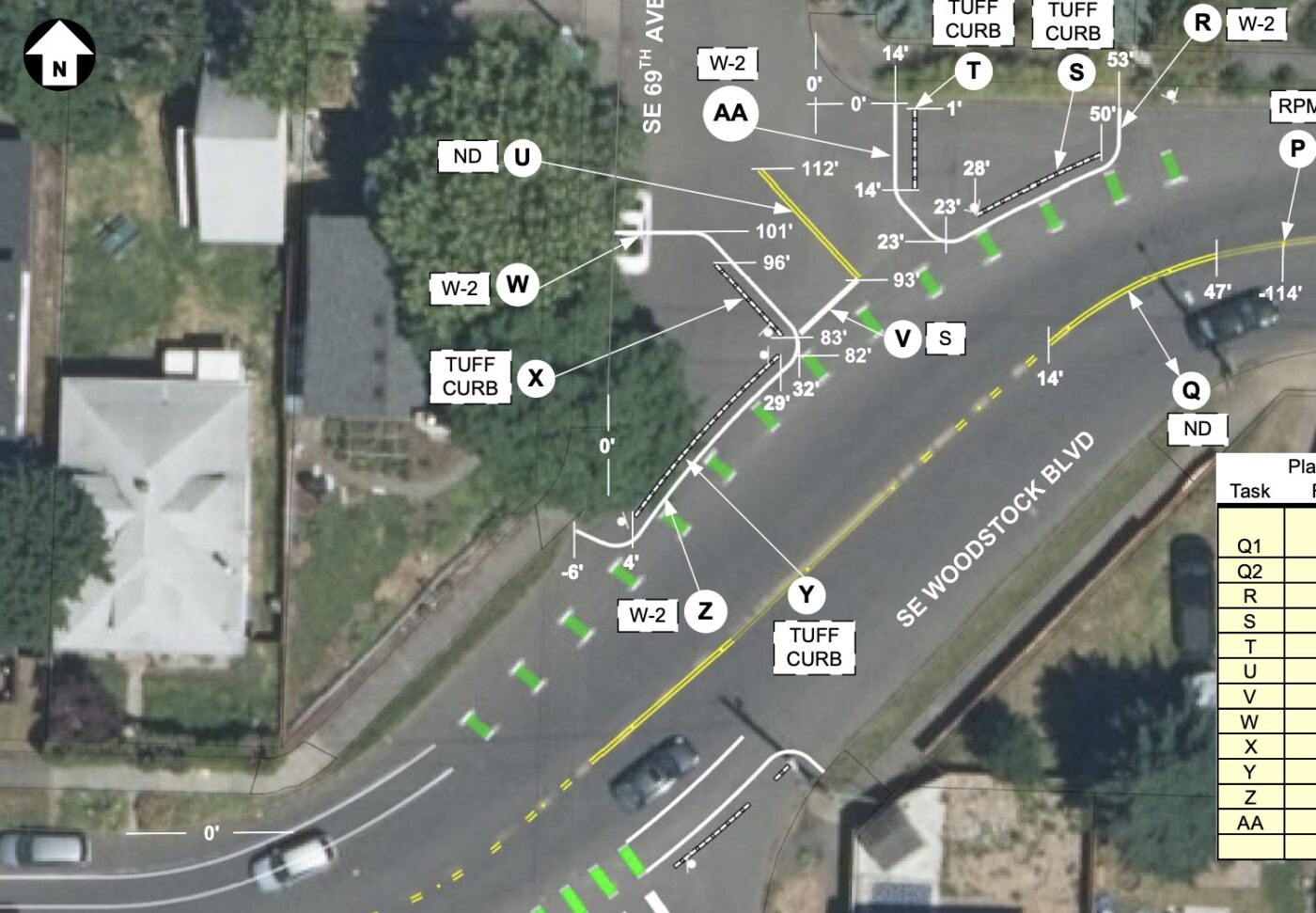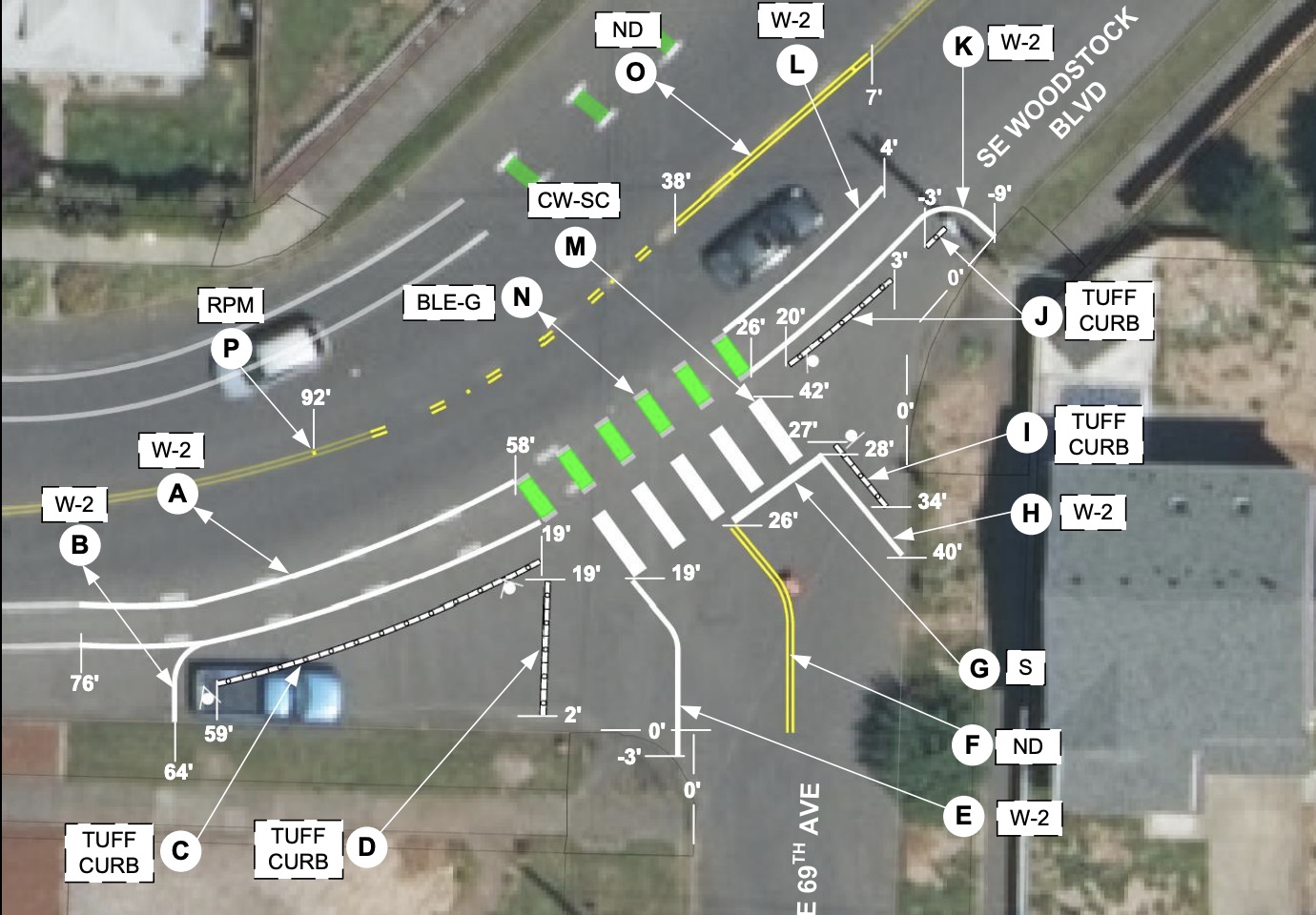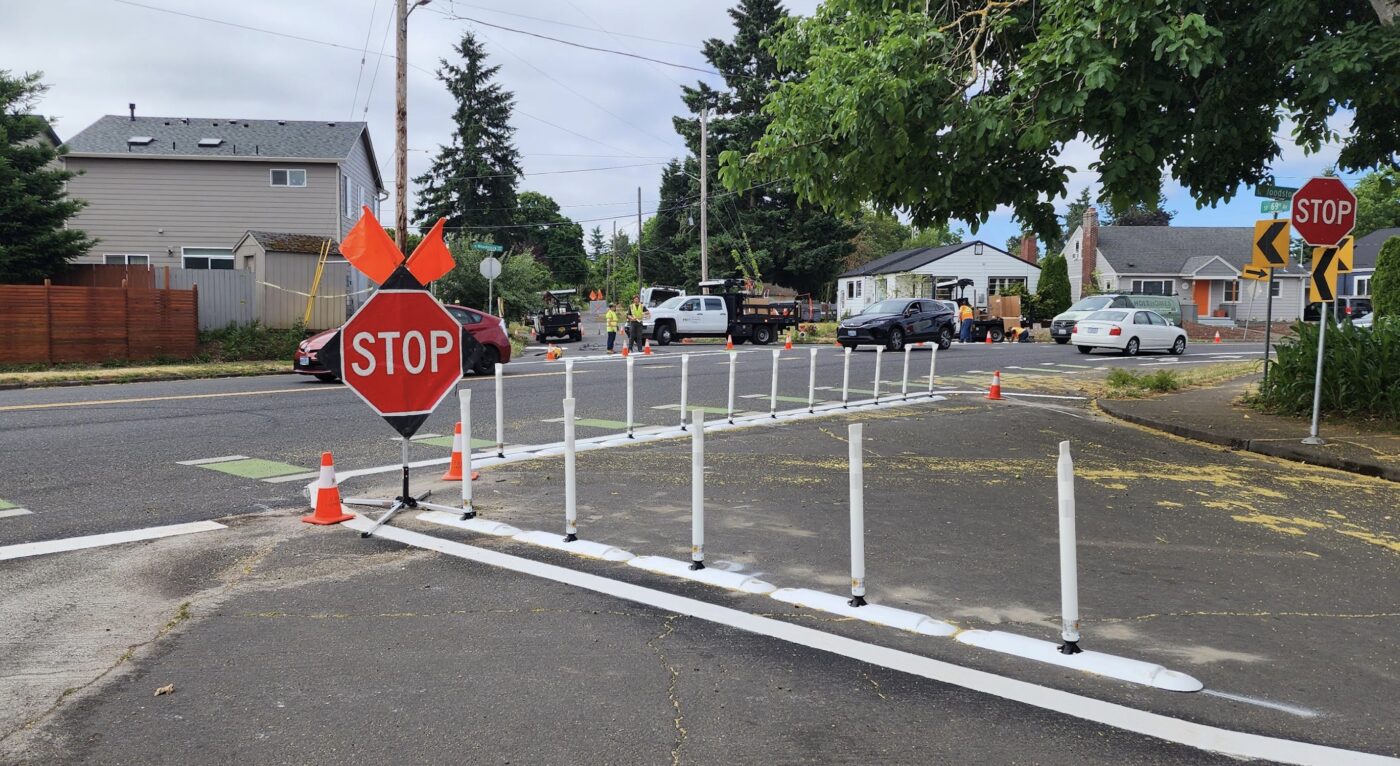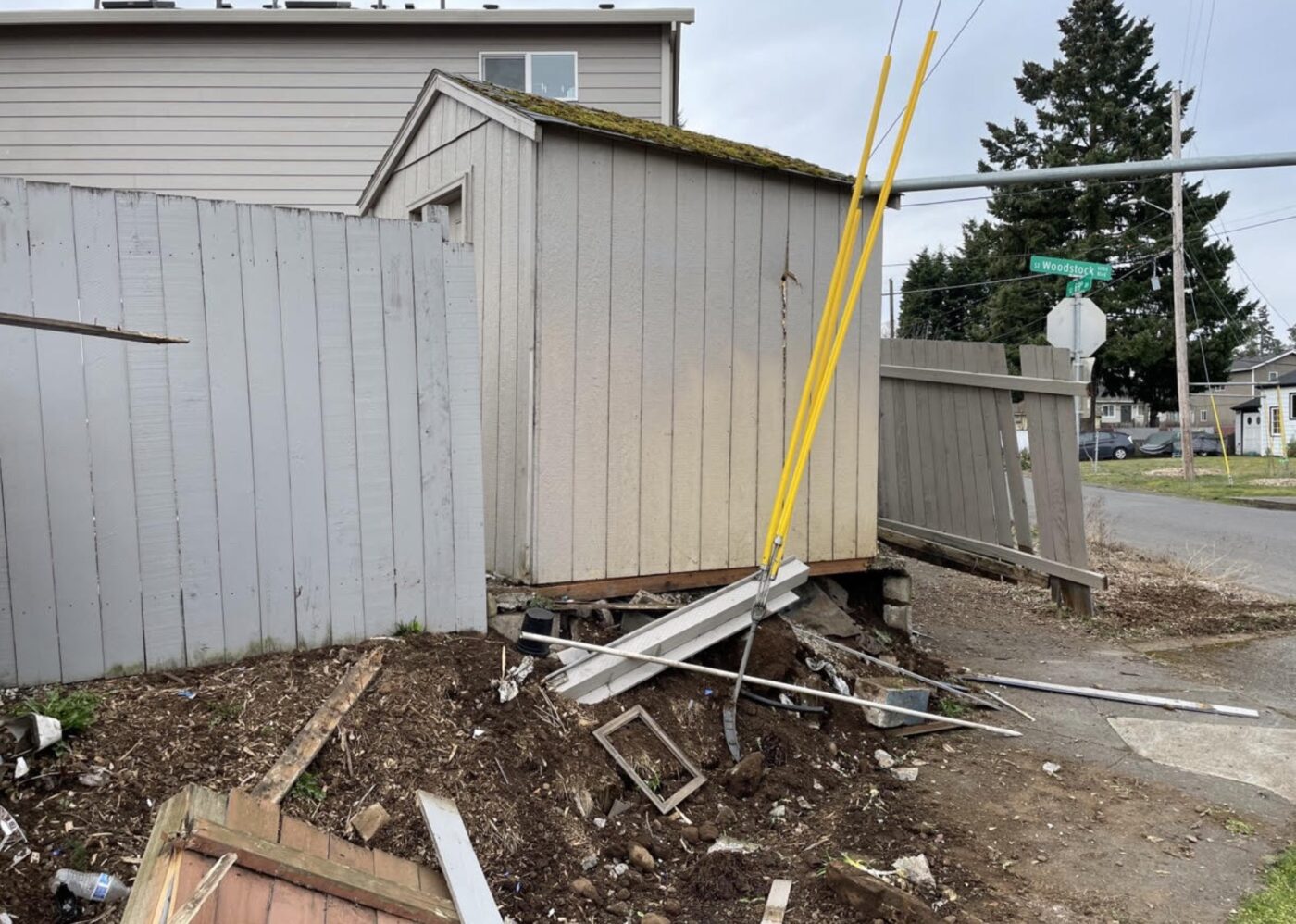The City of Portland has finally taken action to prevent bad drivers from crashing their cars into houses along an intersection in the Mt. Scott-Arleta neighborhood.
Back in January, I shared the story of an s-curve intersection on Southeast Woodstock and 69th. For years, residents told me, they worried that drivers would fail to negotiate the curve outside their homes. And many times, they did. There was a long, documented history of people going too fast and slamming into living rooms, front porches, sheds, and yards. According to the Portland Bureau of Transportation, in the five years between 2016 and 2021 there were seven reported crashes — five of which were a car driver slamming into a house or other object.
The combination of selfish and incompetent car drivers and the design of the wide intersection led to many sleepless nights and significant property damage.
Then late last month, we learned that the Portland Bureau of Transportation implemented a project that squared off the “s” with new pavement striping, plastic curbs and wands.


After my article back in January, nearby resident Ben Mooney reached out to say his home — at the southeast corner of the intersection, in the direct path of eastbound drivers on Woodstock — had been struck several times. His living room wall had sustained major damage and he was left fully responsible for getting it fixed. The crashes continued and it got so bad that he and his wife applied for a city permit to install steel bollards in the sidewalk median. Even though they were willing to pay for the bollards themselves, their application was denied.
They began to meet with PBOT traffic engineers and other neighbors to talk about a solution.
A few nights before one of the meetings in March, Mooney said it happened again (photo at right). “A car failed to make the turn going eastbound, jumped the curb, and crashed into the northwest corner of our property, destroying another section of our fence and damaging our shed,” Mooney wrote in an email to BikePortland. “Thankfully our house was unharmed, but we are still not even done repairing damage from the first event in December.” (In both events, the driver ran off and the car was presumed to be stolen.)
Mooney tried again for the permit and included the BikePortland article (at a PBOT staff person’s recommendation) in an appeal filed in early April of this year. Then they got some good news: They were told the city had received so many complaints that the permit wouldn’t be necessary and that a more long-term infrastructure fix was in the works.
When Mooney and other concerned neighbors learned from PBOT that the fix would be limited to “signs and paint,” he was a bit crestfallen. After one meeting to talk about the changes, Mooney emailed BikePortland to say, “This meeting really underscored how much emphasis is given to cars over the safety of homes, pedestrians, and cyclists, as most of the things we asked about were met with answers about how that would not work because of how it impacts traffic flow.”
After the project was installed in the past few weeks, I reached out to Mooney again to get his impressions.
“While my wife and I would have liked to see something a little more substantial to help reduce speeds going into the curves… now that we’ve seen the changes, we do think that they are an improvement to the intersection. We’re also grateful that they made this intersection a high priority,” he said.
“Cars do seem to be taking the curve at a more cautious pace, so in that regard I do think it is a success.”
Mooney says he’s still concerned about the long straightaway on Woodstock that allows drivers to gain considerable speed for 17 blocks between SE 52nd Avenue and his home. He’s inquired about traffic calming measures like speed bumps or stop signs, but so far PBOT has no plans to implement them.
Hopefully this paint, plastic, and signage is enough. And hopefully, PBOT can find more funding to come back and do something more substantial in the near future.
UPDATE, 7/14 at 4:00 pm: PBOT saw the concerns about the materials used in this project and shared: “The improvements we have installed so far are intended to be a temporary measure until a permanent reconfiguration of the intersection can be funded and built. The Lower SE Rising Area Plan could help advance the discussion of permanent improvements in this location and other parts of the area.”









Thanks for reading.
BikePortland has served this community with independent community journalism since 2005. We rely on subscriptions from readers like you to survive. Your financial support is vital in keeping this valuable resource alive and well.
Please subscribe today to strengthen and expand our work.
plastic curbs and wands? Nope, not nearly enough. C’mon PBOT pour some concrete and show Portland citizens you are really serious about safety.
PBOT crew have indicated to me in other areas that engineers spend more time worrying about liability from damage to cars than anything else. A speeding driver hitting a concrete curb might be injured and SUE the city! Horrors!
Concrete is the best answer, but even a component that would appear to cause minimal cosmetic damage to a car would be a huge improvement.
There was a lonely wand on N Vancouver by the intersection with N Morris that had a backwards facing stop sign attached to it for some reason. Despite being in a place that I would expect drivers to take it out quickly, it was untouched.
If drivers believed that their paint might be scratched by a metal reflective attachment that is put there for safety, I think the wands would be a lot more effective.
Looking forward to the future where it’s possible to sue as a means of getting traffic calming. Our legal system works by lawsuit to a large degree.
Cant say way I would do in that situation but, after a certain point it’s pretty obvious to anyone that the road is unsafe and the city is responsible for it being that way.
Now I’m curious, what’s best way to write laws around liability that would best encourage safe traffic design by cities. I was thinking you could give cities immunity from lawsuits of this nature, but I’m running into the question of how to do this while still making cities liable for bad design. I know absolutely nothing of the case law in this area. Can anyone shed some light on this?
Ironically, having done something half-assed increases the likelihood of city being sued; they admit they know it’s dangerous (half-measures taken) but don’t do anything to actually solve problem.
I have a theory that Portland does so little in so may ways in order to maintain plausible deniability in lawsuits. They don’t have money (or will!) to fix things properly, so they pretend a situation doesn’t exist.
Max, laws change all the time – what’s needed in Portland is a politician directing attorneys to interpret them and defend the city in a consistent way, rather than attorneys telling politicians “nope; you’ll get sued!” and then everyone goes back to hiding under their desks.
Seriously. Maybe concrete is expensive because they have to pour it on something, so they end up needing to tear up the road, etc etc. I wonder why more substantial (concrete and steel) bollards aren’t an option? It seems like those should be relatively cheap. Drill a hole, put in post, fill with concrete. Obviously there would be more details but that’s solvable.
I don’t know what a driver could sue the city for if they lose control and run into an obstacle. Your car will be just as messed up if you drive off the road into a tree or a house, and I don’t think you can (successfully) sue anyone if you destroy your car on their house. I don’t see why anyone would be successful suing the city over crashing their car on anything else. They by definition broke the law and lost control if they hit the bollards / concrete! They should be sued for hitting the concrete!
People can and do sue over things that injured them while they were being idiots. Traffic engineers worry all the time about what might injure a driver if they leave the roadway. They frankly worry more about the driver than they do a pedestrian at risk from the driver. Dead people don’t sue.
People can sue for anything technically. Are you really saying you think a lawsuit could be won if someone plowed their car into a barrier? Wouldn’t that mean they could sue for going off the road and destroying their wheel on the curb? Or a tree? Or what if they drive into a metal barrier on the highway, can they sue for that?
It’s nonsense, I don’t believe it. Like I said, they can technically sue for anything, but I don’t think they would win and if the city settles for something like that, that’s just asking for more frivolous lawsuits.
“Hopefully this paint, plastic, and signage is enough”
Thoughts and prayers. I hope it helps too, but I would bet money that the drivers who are crashing into these houses are impaired and driving way too fast to negotiate the curve in the road. Hard barriers are needed, because similarly impaired drivers speeding on this road will likely just plow through the plastic wands before slamming into the house again.
The city wouldn’t approve steel bollards in the yard, but can the homeowners have giant “landscaping” boulders?
I volunteer to help push a few boulders into the yard.
How long before half of the wands are forcefully removed by negligent drivers?
My guess: about three weeks.
If I were that homeowner, I’d be building a rebar-reinforced “retaining wall” on that corner of my property. You can build right up the sidewalk along the entire property line. And a 3ft bench wall will definitely stop a car.
A few miles from me in vancouver somone with a house in the bulls-eye of a T intersection landscaped their yard with huge boulders that should certainly damage and incapacitate a speeding car. Why are the powers that be in PDX such wimps when dealing with the incompetence and malevolence of the American Motoring Primate?
You could go high, too. There’s already a 2′ h. concrete block retaining wall. You can legally do an 8′ fence on that property line, and you measure fence height from the upper grade (the yard that’s 2′ above the sidewalk) so you could do a wall 10′ high. And like you said it could all be reinforced concrete. Then you could cover it with reflectors.
My first choice, though, would be what he proposed–bollards in the parking strip–and it’s crazy PBOT wouldn’t approve that given the history of crashes. And like so many people are pointing out, wands and curbs aren’t physical barriers. The whole thing to me looks like a nice mockup of a solution, like drawing it on the pavement. But it just stops there, without continuing on to removing paving, adding trees, guardrails, etc.
Just some nice landscape dragon’s teeth!
I knew a guy who put a lock on his front door and then said:
“This lock will keep the honest people out.”
That’s how this street treatment strikes me: it will slow down the careful drivers; the drivers high on meth or fentanyl, speeding in a stolen car, will not slow down for paint and plastic wands.
By the time an inattentive driver gets to the wands (barrier, concrete bollard, etc.) it is too late to prevent a crash. The solution should address the curves prior to the turns. Speed humps can do that and rumble strips ground into the asphalt would also alert drivers to the approaching turn. Rumble strips make noise that could be annoying to neighbors but so do crashes
So they installed something that does absolutely nothing to prevent the types of crashes that were occurring there. Great job, PBOT, as always. Will they ever learn that paint doesn’t stop drunk/high/distracted drivers?
Not until it’s more financially risky for them to do nothing than to pretend that stuff like this will fix it
Paint and wands is wishful thinking.
Jersey barriers with reflectors would be a solution.
Everyone’s talking about the drivers but the houses need to be careful too!
We need a new term for when house recklessly intrude upon the roadway. Jay-lotting?
Seems like the comments section – predictably – agrees with the neighbors that seeing PBOT only put up paint and plastic is a real disappointment.
I do understand the value in “quick-build” safety infrastructure. It’s cheap, goes in fast, and can be reconfigured easily if something isn’t working. It can circumvent the usual years of bureaucratic and community engagement slog that more permanent projects have to go through. Ironically, it can make the general public feel more involved. Build it quick, take comments, and make adjustments based on feedback. It’s a lot harder to conceptualize a project that’s just renders from above and years away from being built, versus seeing and experiencing it IRL.
What I don’t understand though, is PBOT’s aversion to using any kind of hard materials. Concrete planters and jersey barriers are moveable but still solid enough to provide actual protection from errant cars.
Every car-brained histrionic comment about road safety includes some variation of “well pedestrians/cyclists have to be responsible because if they aren’t paying attention they could get hit by a car and physics always wins.” While this is true – I’ve always got my head on a swivel – why can’t drivers also have some risk for their irresponsibility? I think most reasonable people would agree that if you’re driving too fast or not paying attention and your car gets damaged, that’s on you. If you’re crusing down Woodstock going 40 MPH, playing with your phone, and fuck up your car by hitting a jersey barrier, that’s 100% your problem. In the current configuration, you run over some plastic posts and crash into someone’s house and possibly body.
I’d love to understand why PBOT uses ‘hard’ temporary materials so sparsely. Do they have some kind of standard that informs what kind of treatments to use based on the existing street conditions? Do they make decisions on a project-by-project basis? Is it just all whatever vibe the engineers are feeling that day? How can we push them to change that and commit to more protection rather than suggestion? Maybe that’s a subject for Lisa to cover when she’s done jumping down the Alpenrose rabbit hole.
In the meantime, looks like the jersey barriers that you can fill with sand only cost about $400 each. Maybe some folks could pool money together for some Woodstock neighborhood tactical urbanism? I’d throw a few bucks their way.
These newly-cordoned-off areas seem like ideal places to add some miniature green space. Even if they were just grassy bioswales like they have for stormwater management, that would at least provide somewhat of a physical buffer that might stop some cars from reaching the house.
Couldn’t agree more, something needs to go there. If I lived near that corner I would be putting some heavy planters and a bench in that space to further reduce the temptation for drivers to just cut through the flex posts.
There are many other S curves in NE Portland with traffic signals and squared concrete curbs, not plastic posts and paint. It is kind of shocking/not shocking that PBOT hopes/thinks this will work. I’m personally affronted that a licensed Professional Engineer would place their stamp on this “design.”
I sure as hell would not put my license on the line for this grotesqueness.
I’ve mentioned this in other posts recently; We were in the UK/EU this spring and they’re bollard crazy there. Hard, unmovable, car destroying bollards. It was amazing. Don’t want cars in the plaza? Hard bollards. Don’t want cars on the sidewalks? Hard bollard. Don’t want cars on the bike infrastructure? Hard bollards. Priorities and values between us and them are clearly different.
Yes!
Traffic engineers in the US.
Well if the city wont let them put bollards up, they should just park a few dumpy motorhomes out there. The city doesn’t seem to do anything about them out here in SE (except around Woodstock Park).
I love a good handcuffing. Call the city to fix a situation and they point right at this wild project. “Uh… yeah, you should call the SE Rising team and tell them this concern.” Do better PBOT project managers.